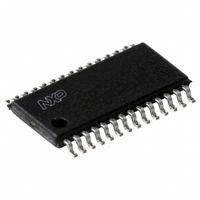P89LPC931A1FDH,512 NXP Semiconductors, P89LPC931A1FDH,512 Datasheet - Page 29

P89LPC931A1FDH,512
Manufacturer Part Number
P89LPC931A1FDH,512
Description
IC 80C51 MCU FLASH 8K 28-TSSOP
Manufacturer
NXP Semiconductors
Series
LPC900r
Datasheet
1.P89LPC9301FDH512.pdf
(66 pages)
Specifications of P89LPC931A1FDH,512
Program Memory Type
FLASH
Program Memory Size
8KB (8K x 8)
Package / Case
28-TSSOP
Core Processor
8051
Core Size
8-Bit
Speed
18MHz
Connectivity
I²C, SPI, UART/USART
Peripherals
Brown-out Detect/Reset, POR, PWM, WDT
Number Of I /o
26
Ram Size
256 x 8
Voltage - Supply (vcc/vdd)
2.4 V ~ 3.6 V
Oscillator Type
Internal
Operating Temperature
-40°C ~ 85°C
Processor Series
P89LPC
Core
80C51
Data Bus Width
8 bit
Data Ram Size
256 B
Interface Type
I2C, SPI, UART
Maximum Clock Frequency
18 MHz
Number Of Programmable I/os
23
Number Of Timers
3
Operating Supply Voltage
2.4 V to 3.6 V
Maximum Operating Temperature
+ 85 C
Mounting Style
SMD/SMT
3rd Party Development Tools
PK51, CA51, A51, ULINK2
Minimum Operating Temperature
- 40 C
Lead Free Status / RoHS Status
Lead free / RoHS Compliant
For Use With
568-1758 - BOARD EVAL FOR LPC93X MCU FAMILY
Eeprom Size
-
Data Converters
-
Lead Free Status / Rohs Status
Lead free / RoHS Compliant
Other names
935288634512
NXP Semiconductors
P89LPC9301_931A1
Product data sheet
7.22.4 Mode 3
7.22.5 Baud rate generator and selection
7.22.6 Framing error
7.22.7 Break detect
7.22.8 Double buffering
11 bits are transmitted (through TXD) or received (through RXD): a start bit (logic 0), 8
data bits (LSB first), a programmable 9
the same as Mode 2 in all respects except baud rate. The baud rate in Mode 3 is variable
and is determined by the Timer 1 overflow rate or the baud rate generator (described in
Section 7.22.5 “Baud rate generator and
The P89LPC9301/931A1 enhanced UART has an independent baud rate generator. The
baud rate is determined by a baud-rate preprogrammed into the BRGR1 and BRGR0
SFRs which together form a 16-bit baud rate divisor value that works in a similar manner
as Timer 1 but is much more accurate. If the baud rate generator is used, Timer 1 can be
used for other timing functions.
The UART can use either Timer 1 or the baud rate generator output (see
that Timer T1 is further divided by 2 if the SMOD1 bit (PCON.7) is cleared. The
independent baud rate generators use OSCCLK.
Framing error is reported in the status register (SSTAT). In addition, if SMOD0 (PCON.6)
is logic 1, framing errors can be made available in SCON.7 respectively. If SMOD0 is
logic 0, SCON.7 is SM0. It is recommended that SM0 and SM1 (SCON.7:6) are set up
when SMOD0 is logic 0.
Break detect is reported in the status register (SSTAT). A break is detected when
11 consecutive bits are sensed LOW. The break detect can be used to reset the device
and force the device into ISP mode.
The UART has a transmit double buffer that allows buffering of the next character to be
written to SnBUF while the first character is being transmitted. Double buffering allows
transmission of a string of characters with only one stop bit between any two characters,
as long as the next character is written between the start bit and the stop bit of the
previous character.
Double buffering can be disabled. If disabled (DBMOD, i.e., SSTAT.7 = 0), the UART is
compatible with the conventional 80C51 UART. If enabled, the UART allows writing to
SBUF while the previous data is being shifted out. Double buffering is only allowed in
Modes 1, 2 and 3. When operated in Mode 0, double buffering must be disabled
(DBMOD = 0).
Fig 6.
baud rate generator
Baud rate sources for UART (Modes 1, 3)
timer 1 overflow
(CCLK-based)
(PCLK-based)
All information provided in this document is subject to legal disclaimers.
Rev. 2 — 29 November 2010
8-bit microcontroller with accelerated two-clock 80C51 core
÷2
SMOD1 = 1
SMOD1 = 0
th
data bit, and a stop bit (logic 1). In fact, Mode 3 is
selection”).
P89LPC9301/931A1
SBRGS = 0
SBRGS = 1
baud rate modes 1 and 3
© NXP B.V. 2010. All rights reserved.
Figure
002aaa897
6). Note
29 of 66















